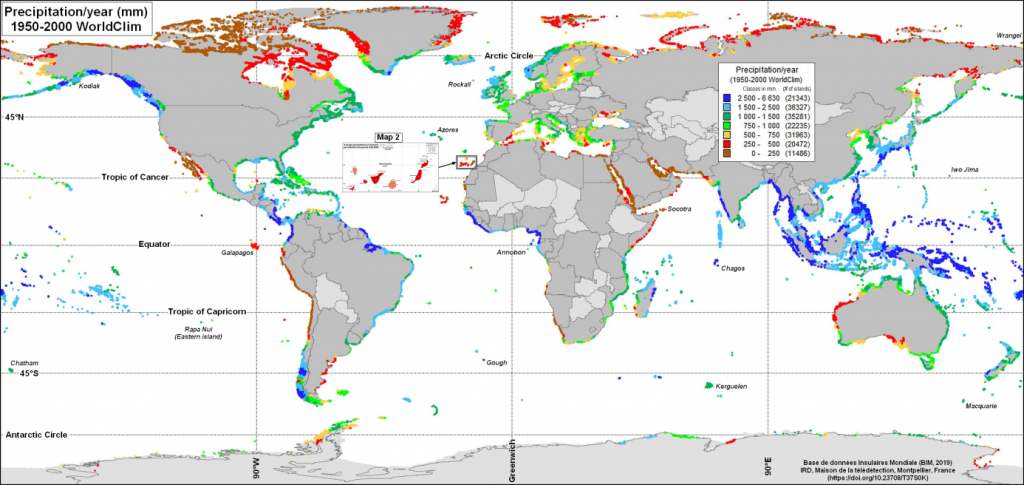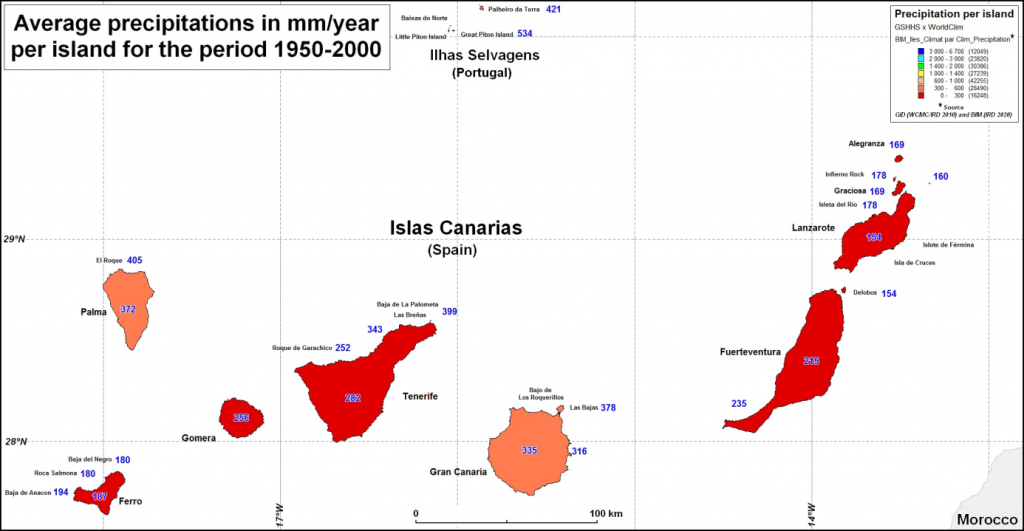Oceanic islands are often at the top of the freshwater scarcity index; as paradoxical pieces of land, they are sea-locked but their fresh and brackish water supplies are land-locked. That is to say, in a metaphoric, analogic and geopoetic way, the tiny oceanic islands are fragile oases with limited freshwater amenities surrounded by a boundless desert-like salty ocean.
In addition to brackish groundwater and a lack of annually flowing rivers, some islands face a pollution of aquifers through toxic volcanic gasses, deforestation, desertification, and overexploitation of water resources (WR) through water-intensive monoculture crops and mismanagement of domestic water supplies. Even flashfloods can exacerbate limited freshwater supplies by dragging pollutants into water storage systems, such as cisterns. Islands receive proportionally more precipitation than continents due to their oceanic context, as they are directly under the influences of Tradewinds and westerlies. Conversely, as “sealocked” and relatively small pieces of land, they only collect rainwater from their area and cannot benefit from “WR externalities” such as large regional or continental aquifers or huge allochtone rivers with their source in more humid zones (i.e. the Nil). Consequently, due to their little size, their catchment basins are small with erratic streamflows with either sudden and devastating flash floods or no water flow at all during the dry season. The decennial “WR inertia” of small islands is limited to mitigate the interannual fluctuations of rainfalls which is a universal phenomenon on a hydroclimatologic mesoscale of about 10,000 km² corresponding to medium size islands (i.e. Cyprus) The driest islands are mostly located in the Red Sea, in addition to Socotra, Jerba, and the western Canary Islands of Lanzarote and Fuerteventura (Map 1).

The erraticism of variable oceanic weather patterns and terrestrial hydrological processes combined with a disconnection from large land-based water support prompts islands to reveal drastic signs of the worsening of climate and environmental changes before they appear on the mainland (Depraetere & Morell 2009). Also the geographical isolation of small islands and their limited physical size can make the effects of climate change and implications for water supplies more severe than on the mainland (Ratter 2018). The smaller and lower the island, the greater reliance on groundwater it has; a major drawback for islanders is the fragile equilibrium of the freshwater lens with the surrounding seawater and the difficulty of pumping floating freshwater without saltwater entering the supply; this is why Integrated Water Resource Management (IWRM) is more than elsewhere a vital approach to fulfil an optimal use of the resource for the locally-based various economic sectors, overall health issues, and island biodiversity, in short for social development (Depraetere et al. 2020).
A lack of freshwater is also detrimental for agriculture, tourism and island life at large. For example, it is a common trait of islandness that only a few crop varieties are grown on small islands, making the effects of crop failure harmful for the economy and local food supplies (Royle 2004). Also limited specialized labourers on small islands (e.g. engineers) may not be able to provide continuous solutions to hydraulic infrastructure problems created by storms, to which small islands are especially susceptible (Braje et al. 2017, cf. also “stone gardening” to avoid soil erosion and gullies on sloping fields (Mieth & Bork 2004). The governance structure and level of political corruption of a given society directly affects the distribution of water supplies. Especially on islands where freshwater supplies are in private hands, limited access to water exasperates already existing income inequalities; islanders without “hydraulic citizenship” may suffer from a diminished ability to participate in society (Anand 2017). Conversely, the availability of low-cost water when subsidised by local authorities generally induces an over-consumption and waste of water resources.
But the picture is not only bleak. Studying island water scarcity sheds light on the coping mechanisms, adaptations, and innovation of islanders over centuries (Schön & Dierksmeier 2021). In some cases, islanders provide examples that could be implemented mutatis mutandis on other islands or the mainland; as such they should be considered as bellwethers to cope with ongoing environmental changes and evolution of the societies to deal with mitigation/adaptation to climate change. For example, on the Canary islands from 1500-1800 (Map 2), a separate water police force was implemented to protect water supplies, water-yielding plant species called “Fountain Trees” were carefully guarded, low-cost domestic solutions to distil water were employed (“La destiladera Canaria”), extensive cisterns collected rain water, fog moisture was collected from pine trees, academic societies (Real Sociedad de Amigos del País) awarded prizes for innovation technological solutions, and communities came together to protest for their needs until news travelled to the mainland to reach people who could help them (Dierksmeier 2020; Gioda et al. 1995A and 1995B).

Water scarcity on islands also affects religious and cultural practices. For example, the “DiNapolito’s hypothesis” tries to explain the putative relations between the sacred zones with ahu statues and freshwater, one of the most critical resources on Rapa Nui. The hypothesis suggests that the locations of ahu are explained by their distance from coastal seeps, demonstrating the vital importance of coastal freshwater resources (DiNapoli et al. 2019). Despite the fact that Rapa Nui receives 1,177 mm/year of water on average, surface and sub-surface WR storage are erratic due the porosity and permeability of the volcanic basement. The utmost sign of precontact Pascuan populations’ dependencies on water resources stands on the fact that the hypnotic gaze of ahu are screening the island hinterland and NOT the open-sea; it illustrates the tight entanglement of hydrological and societal factors in constrained insular geographical contexts.
Water scarcity derives from manifold geological and geographical challenges, with a long history of solutions to one of the most significant enigmas of island life.
Christian Depraetere & Laura Dierksmeier
References
Anand N, 2017. Hydraulic City: Water and the Infrastructures of Citizenship in Mumbai. Durham: Duke University Press, 2017.
Braje, T. J. / Leppard, T. P. / Fitzpatrick, S. M. / Erlandson, J. M. Archaeology, historical ecology and anthropogenic island ecosystems. Environmental Conservation 33:3, 2017, 286–297.
Depraetere C., Morell M., 2009: “Hydrology of islands”. In Encyclopedia of Islands, edited by Rosemary G. Gillespie and David A. Clague, Encyclopedias of the Natural World, n°2, University of California Press, July 2009, pp. 420-425.
Depraetere C., Soulis K.X., Tsesmelis D.E., Avgoustidis G., Spilanis I. (2020). Impacts of climate change on the evolution of water resources in the context of the Mediterranean islands using as an example two Aegean Sea islands : consequences for touristic activities in the future. In The anthropocene and islands : vulnerability, adaptation and resilience to natural hazards and climate change. Lago : Il Sileno, 3, 143-182. (Geographies of the Anthropocene ; 2).
Dierksmeier, L. (2020), Historical Water Scarcity on the Canary Islands, 1500-1800 AD. In: S. Teuber, A. Scholz, T. Scholten, & M. Bartelheim (eds.), Waters as a Resource. SFB 1070, Tübingen: University of Tuebingen Press, 39 – 47.
DiNapoli RJ, Lipo CP, Brosnan T, Hunt TL, Hixon S, Morrison AE., Becker, M (2019). Rapa Nui (Easter Island) monument (ahu) locations explained by freshwater sources. PLOS ONE Journal 14(1). Publisher Public Library of Science, January 2019, 27 pages.
Mieth, Andreas. & Bork, Hans-Rudolf. (2004). Easter Island – Rapa Nui : scientific pathways to secrets of the past. Kiel, Germany: Ecology Center. 109 pages, 49 figures. (cf. Figure 7 page 18, aerial view of the freshwater lake of Rano Raraku).
Gioda A., Hernandez Z., Gonzales E., Espejo R. (1995A). Fountain trees in the Canary islands : legend and reality. Advances Horticultural Science, 9, p. 112-118. https://www.documentation.ird.fr/hor/fdi:010078642
Gioda, A., Maley, J., Guasp, R.E., Acosta Baladón, A. (1995B). Some Low Elevation Fog Forests of Dry Environments: Applications to African Paleoenvironments. In: Hamilton, L.S., Juvik, J.O., Scatena, F.N. (eds) Tropical Montane Cloud Forests. Ecological Studies, vol 110. Springer, New York, NY. https://doi.org/10.1007/978-1-4612-2500-3_10
Ratter, B. M. W. Geography of Small Islands: Outposts of Globalisation (Cham 2018).
S. A. Royle, A Geography of Islands: Small Island Insularity (London 2004).
Schön, F. & Dierksmeier, L. (2021), Water Scarcity at Sea: Historical and Archaeological Perspectives on the Preservation of Freshwater on Volcanic Islands. In: T. Schade, B. Schweizer, S. Teuber, R. Da Vela, W. Frauen, M. Karami, D. Kumar Ojha, K. Schmidt, R. Sieler, & M. Toplak (eds.), Exploring Resources. Tübingen: University of Tübingen Press, 157 – 182.
